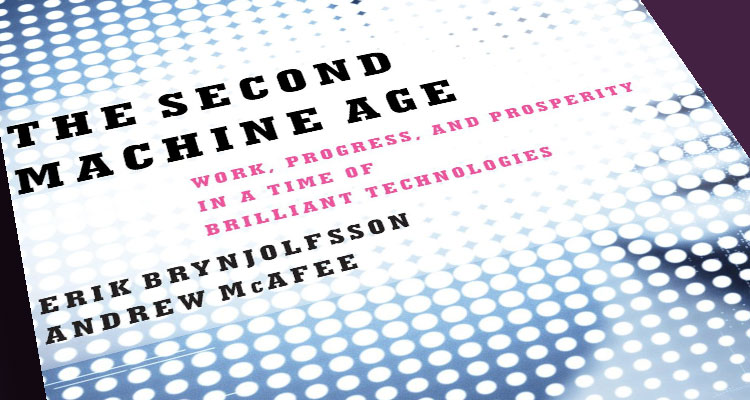 Book by the Noteworthy.
Book by the Noteworthy.
THE SECOND MACHINE AGE, by Erik Brynjolffson and Andrew Mcafee (W.W. Norton, 2014.) See also : www.secondmachineage.com
It is interesting that books about technology are always around for a while and then typically are relegated to shelves in libraries, though I got a recent recommendation, source un – remembered but it might be written down somewhere, to read through this text that stops in 2014, before AirBnB and Uber, for example, but that contains many what are now classic technological models, innumerable, many, that help us to regulate and conduct our lives in the West. The thesis of the text is not for the faint of heart as it notes the overall primacy of customized and tailored technologies in the West whereas the East has a different technological paradigm for business and for the end – user. The really big technology topics that comprise the tech “chessboard” through 2014 included (still) some classic hard and softcover books such as those by J.M. Keynes, V. Leontief, L. Pauling, J.A. Schumpeter and the like on macroeconomics (the great text by Paul Samuelson omitted), and this along with other literature by K. Jaspers, Voltaire, M. Poliyani, even E. Hemingway (The Sun Also Rises). The machines the text illustrates and talks about are shown using various references, from journalistic to research sites, to government sites, to the blogosphere, Yahoo!, economics and business sites, the 1912 Sears Catalog, media sites like YouTube.com, CNBC.com, huffingtonpost.com and so on.
The innumerable technologies that innovate our lives and our conduct, making us more productive and more creative, less “organized” and “conforming” include the prophecies of I. Asimov and A.C. Clarke (remember the difference between technology and magic), some of the Microsoft software products for Xbox, Cisco Systems, IBM Watson AI functionality, Smartphones and iPhones (anew sometimes every few weeks), the gigantesque WalMart hypermarket, the innovations of the federal reserve system, various technology institutes including the Upjohn Institute, the predictions of Albert Gore (The Future Six Drivers of Global Change), the greater and greater uses of the wikis including Wikipedia, the varied and sundry, innumerable themselves – SMS services; Facebook, innovations and inventions in digital photography, Google, the innovating internet sites of newspapers, Forbes.com, census.gov; Garry Kasparov, the Saint Louis Fed, the Stuxnet virus, and numerous, many, many educational and business, economics and gaming sites : Too many to name in all (apologies).
All this calls for more and more and faster and faster computing. Check out the book’s supercomputer sites including riken.jp; intel.com; green500.org; ed-thelen.org; and Akamai.com – some people are more familiar with the technology scheme here than others, and remember it all is still hardware and software. I picked up this book due to the recent discussion everywhere about advances in artificial intelligence and computing advances at the same time. When I first heard about artificial intelligence, actually during the late 1960’s and its technologies – then mostly possibilities, potentialities and with some promise, especially concerning hardware – artificial smarts were just about circuitry and processing speed. Then fast forward to the “second machine age”, the age of smart everything, including many, ever so many processes involving the interaction and adaptation of hardware and software in machines and computing, and this includes calculations, etc., where human intelligence, the memory and problem solving parts of it, are easily broken down and while still creative and innovative winners, are left far in the back distances by computing devices and technology models that have become everyday, routine for the consumer and even boring for the engineer who was inspired by them (when this book was published) less than four years ago. This shows the limitations of computing – of which there really are not any, none, and the infinite possibilities that one considers when starting in on the items above and related goods, services, virtual or tangible, and the like. The quality of these and the innovation has a cost that has really yet to be assessed, and this is so difficult given the social and other intangible benefits of social media, add Twitter and Instagram and so on, and efforts of policy – makers to better stratify personal income, not as social policy nor as vote – getting, but as a sound way too continue to get beyond the economic models of 1870 – 1929. Concerning these items, maybe consider Michael Spence’s book The Next Convergence, or Why the West Rules, by Ian Morris. The number of books on the topic are themselves innumerable and everyone has a favorite. Remember the text here is macroeconomic in its scope and looks at business, economy, innovation, creativity, invention and so on from the age old perspective of classical economics as started by Adam Smith. The text itself is wondrous in its repeated mentioning of Watson, Nike, webification of different things, Google, China, politics and policy in the States related to all this, and for a four year – old book, just about, that is quite good these days; not an instabook. It goes from there the many levels and facets in the analysis of the text about technology and its merits, its burdens, all in the various industrial and sectoral economics, commercial and business models that are picked up by the Wall Street mavens and traded, turned upside down, and so on. It is interesting that economics and business has emerged from the twentieth century, and this a central idea in this narrative, as a system, open and growing, still and a far cry from the horse trader wiseguys of the old exchanges and marketplaces. There might be vestiges of these in some places, the places where bargain – hunters meet with dealmakers even for small purchases such as at public squares on Saturday, and this is charming though the book really eschews discussing this in favor of the bounty made in a streamlined and digitized marketplace where the asymmetries, whereas person to person there are many, in the GDP we have today, actually few.
Advertisements Share this:




